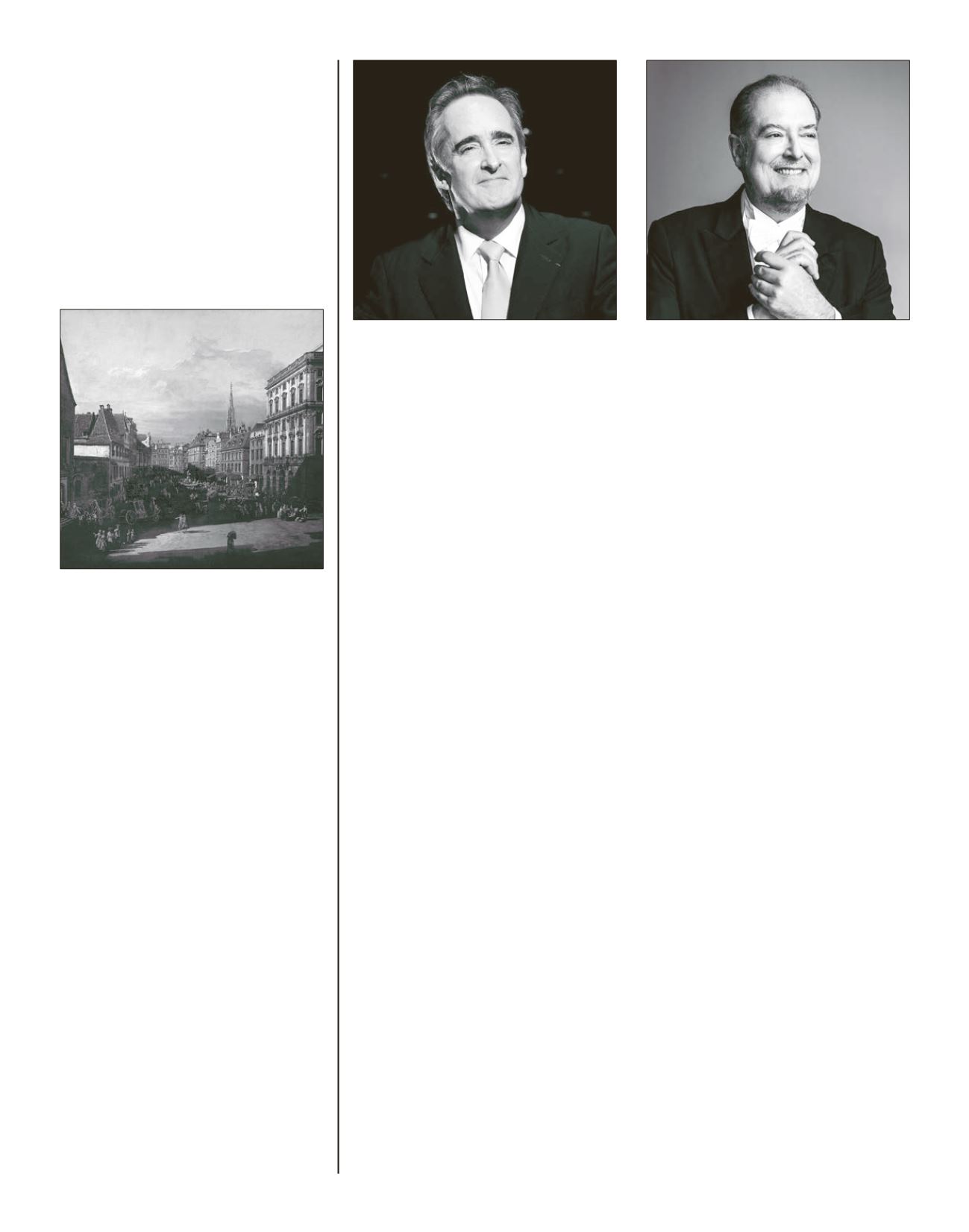
JAMES CONLON,
conductor
Since his New York Philharmonic debut in
,
James Conlon has conducted virtually every
major North American and European orchestra
and proved himself one of today’s most versatile
conductors. Conlon has been engaged as music
director of Los Angeles Opera since
, and
last year he became principal conductor of the
RAI National Symphony Orchestra in Turin, It-
aly, the rst American to hold the position in the
ensemble’s -year history. He served as music
director of the Cincinnati May Festival for
years (
– ), one of the longest tenures as
a director of an American classical music insti-
tution, and is now its Conductor Laureate. Con-
lon also served for years (
– ) as music
director of the Chicago Symphony Orchestra’s
residency at Ravinia, where he rst conducted in
, during his tenure leading complete orches-
tral cycles of Mahler’s symphonies and Mozart’s
piano concertos, several operas, and gala perfor-
mances featuring Van Cliburn, Plácido Domin-
go, Patti LuPone, and Jessye Norman, among
many others. He has also held the positions of
principal conductor of the Paris National Opera
( – ); general music director of the City
of Cologne, Germany (
– ), leading both
the Gürzenich Orchestra and Cologne Opera;
and music director of the Rotterdam Philhar-
monic ( – ). His extensive opera credits
include over
performances at New York’s
Metropolitan Opera since his
debut, as well
as conducting at Teatro alla Scala, Vienna State
Opera, Maggio Musicale Fiorentino, Covent
Garden, the Mariinsky
eater, and Lyric Op-
era of Chicago. To call attention to composers
whose music was suppressed by the ird Reich,
Conlon programs their music with numerous
American and European orchestras, an initiative
that earned him the Anti-Defamation League’s
Crystal Globe Award in
as well as the Rog-
er E. Joseph Prize from the Hebrew Union Col-
lege/Jewish Institute of Religion in
. In ad-
dition to four Grammy Awards, his honors also
include the Zemlinsky Prize, the Medal of the
American Liszt Society, the Sachs Fund Prize for
his cultural contributions to Cincinnati, and the
inaugural
Opera News
Award, as well as being
named to France’s Order of Arts and Letters and
Legion of Honor.
while making a transition to his surprisingly
delicate second theme in B- at major.
e pi-
ano enters with a gentle new melody, but the
D-minor music quickly returns. A er a pause,
the keyboard states the lyrical second theme be-
fore introducing its own melodic idea. Develop-
ment begins with the piano, a section extended
through several changes of key and false reca-
pitulations. A brief solo piano interlude leads
into an orchestral restatement of the D-minor
theme. Mozart rearranged his original sequence
of melodies. A solo cadenza (none by Mozart
have survived) gives way to a brief minor-key
postlude.
e lovely
Romanze
in B- at major momentar-
ily disperses the overwhelming sense of gloom.
Mozart enhanced its melodic simplicity by re-
ducing orchestral involvement to phrase repeti-
tion and faint harmonic support. A middle por-
tion explodes in minor-key vehemence, which
eventually dissolves into the comforting strains
of the
Romanze
. Much of the rondo’s customary
optimism is lacking in the nal movement. e
refrain and all but one episode tarry in minor
keys. However, Mozart relieves this emotional
oppression a er the cadenza with a dual piano/
orchestra coda in D major.
–Program notes ©
Todd E. Sullivan
GARRICK OHLSSON,
piano
Born in White Plains, NY, pianist Garrick Ohls-
son began his musical studies at the Westchester
Conservatory of Music at age , ve years later
entering e Juilliard School. Under the tutelage
of such keyboard luminaries as Claudio Arrau,
Olga Barabini, Tom Lishman, Sascha Gorod-
nitzki, Rosina Lhévinne, and Irma Wolpe, he
became the rst-prize winner of both the
Busoni and the
Montreal Piano Competi-
tions. To this day Ohlsson retains the distinc-
tion of being the only American to earn the gold
medal in Warsaw’s International Chopin Piano
Competition (in
), and he has since con-
ducted many concert tours of Poland. His hon-
ors also include the Avery Fisher Prize in
,
the University Musical Society Distinguished
Artist Award from the University of Michigan in
, and Northwestern University’s
Jean
Gimbel Lane Prize, which included a multiweek
residency at the school. Additionally, Ohlsson
won a Grammy Award in
for the third
disc of his acclaimed cycle of Beethoven’s pia-
no sonatas for Bridge Records. His discography
also includes albums on the Arabesque, RCA
Victor Red Seal, Angel, BMG, Delos, Hänssler,
Nonesuch, Telarc, and Virgin Classics labels,
and he recently appeared on concert recordings
by the Czech Philharmonic and Sydney and
Melbourne Symphonies, playing concertos by
Dvořák, Tchaikovsky, and Brahms, respectively.
In
Ohlsson was featured in the documenta-
ry
e Art of Chopin
, co-produced by European
and Chinese media, as well as a DVD including
performances of the composer’s two concertos
the following year. In addition to solo appear-
ances with orchestras and in recital, he also reg-
ularly collaborates with violinist Jorja Fleezanis
and cellist Michael Grebanier as the FOG Trio.
Ohlsson has also performed chamber recitals
with the Cleveland, Emerson, Takács, and To-
kyo String Quartets, and he has accompanied
such vocalists as sopranos Magda Olivero and
Jessye Norman and contralto Ewa Podleś. Gar-
rick Ohlsson was on the faculty of Ravinia’s Ste-
ans Music Institute in
, having been a regu-
lar performer at the festival since
. Tonight
marks his nd season at Ravinia.
The Mehlgrube, on the right, by Bernardo Canaletto
(1760)
AUGUST 6 – AUGUST 12, 2018 | RAVINIA MAGAZINE
111








